The Sick LBR SicWave is a bulk solids level sensor with a range up to 120m and the Sick LFR SicWave is a fluid level sensor with a maximum range of 30m. The company said both represent a breakthrough technology for continuous level measurement used to optimize material storage in food and drink processing, for example in bulk silos such as flour, or sugar, as well as for large fluid stirring and preparation tanks, or thickener and filling tanks.
The SICK SicWave uses higher-frequency 80 gigahertz free-space radar to overcome the limitations of lower-frequency radar sensors or mechanical devices in demanding environments to achieve precision continuous level measurement in demanding environments.
Where previously operators have settled for switch point level indication or have been challenged by using non-contact sensors in harsh environments, the narrowly-focused highly-effective energy microwave pulses of the SicWave sensors penetrate dust, vapor and material build-up to output accurate results.
Darren Pratt, Sick UK product manager for industrial instrumentation, said, “Any processor who needs to manage the supply of liquids or solids in storage vessels will understand the frustrations that can be caused when trying to achieve a reliable level measurement using a non-contact optical or radar principle when the signal is disrupted by the presence of dust, moisture, build-up of residue, or by other obstructions in the vessel.
“When positioned at the top of a tank or silo, or over a heap or bunker, a SICK SicWave sensor sends a highly-focused narrow beam of microwave radar pulses and uses the time-of-flight principle to return a high-quality signal even at exceptionally long ranges or extreme temperatures and pressures.”
The Sick SicWave 80 GHz free-space radar sensors are 1,000 times more sensitive than previous-generation 26 GHz radar technologies, which the company said ensures high availability in challenging environments with minimal maintenance requirements. The narrow field of view also avoids the potential for false signals caused by deposits on walls or by other obstructions inside the vessel and ensures focused alignment to enable simple and rapid set-up.
Sick said remote set-up and interrogation of the sensors is straightforward, either using the on-board WPAN interface to a smartphone or tablet via Bluetooth or through standard HART communication, which also enables integration with higher level controls and diagnostic systems. The sensors have a standard 4-20 mA output, enabling signals to be monitored and displayed on a dashboard in a cloud environment using IIoT gateways such as Sick’s Telematic Data Collector.
The SicWave LFR fluid level sensor and LBR bulk level sensor come in a range of space-saving antenna designs, flange or thread process connections and a range of application-specific mounting options. All sensors are certified for use in ATEX and IEC Ex explosive environments.
The Sick LFR SicWave measures fluid levels reliability between -196°C and +200°C, and process pressures between -1 and 25 bar. It measures bulk solid levels reliably at process temperatures between -40°C and +200°C and at process pressures between -1 and 20 bar.
“The 80 GHz free space radar technology, when combined with the wide-ranging application versatility of these sensors, promises to be a true gamechanger for many food and drink processors working in demanding environments,” Pratt said.
“Whether you have struggled with dust clouds when filling a silo, or with steam in a tank, the Sick SicWave free-space radar opens up the potential to optimize your material flows by enable high-availability continuous measurement.”

